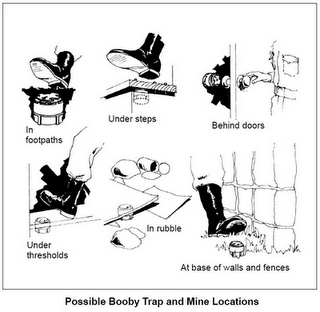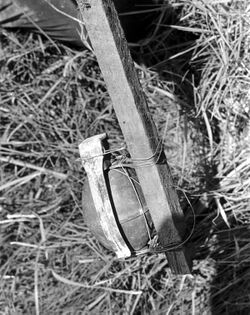Booby Trap

A Booby Trap is a trap designed to kill or severely injure people. As the word trap implies, they often have some form of bait designed to lure the victim towards it. However, in other cases the device is placed on busy roads or is triggered when the victim performs some type of everyday action e.g. opening a door, picking something up or switching something on. Booby traps should not be confused with mantraps which are designed to catch a person. Lethal booby traps are often used in warfare, particularly guerrilla warfare,
A military booby trap may be used to give away the location of an enemy by triggering a signalling device, or it may be designed to kill or injure a person who activates the trap. Most, but not all, military booby traps involve explosives.
There is no clear division between a booby trap and conventional, mass produced land mines which are usually hidden under soil, but may be triggered by a tripwire or directional mine designed specifically to work with a tripwire. Other, similar devices include spring-guns and related mechanisms.
What distinguishes a booby trap is that it is contrived to work in an unexpected manner that takes advantage of the victim's ignorance of the mode of operation. It naturally follows that booby trap designs must be many and varied and for this reason the traps are often at least partially improvised from some item of ordnance such as an artillery shell, grenade, or quantity of high explosives. However, some mines have features specifically designed for incorporation into booby traps and armies have been equipped with a variety of mass produced triggering mechanisms intended to be incorporated into booby traps in a wide variety of ways.
A booby trap is generally concealed or disguised in some way so that it either cannot be seen or looks harmless. Typically, a booby trap will be hidden inside, behind or underneath another object.
Part of the skill in placing booby traps lies in exploiting natural behaviors such as habit, self-preservation, curiosity or acquisitiveness. A common trick is to provide victims with a simple solution to a problem, for example, leaving only one door open in an otherwise secure building, thereby luring them straight toward the firing mechanism.

An example that exploits an instinct for self-preservation was used in the Vietnam War. Spikes known as Punji sticks were hidden in a grassy area. When fired upon, passing soldiers unknowingly take cover in the booby trapped area, throwing themselves down on the spikes.
Attractive or interesting objects are frequently used as bait in order to lure victims into triggering the booby trap.
Purpose-built booby-trap firing devices exist which allow a variety of different ways of triggering explosives e.g. via trip wire (either pulling it or releasing the tension on it), direct pressure on an object (e.g. standing on it), or pressure release (lift/shift something) etc. A wide variety of designs was produced during The Second World War by Britain’s department MD1.
Almost any item can be booby-trapped in some way. For example, booby trapping a flashlight is a classic tactic: a flashlight already contains most of the required components. First of all, the flashlight acts as bait, tempting the victim to pick it up. More importantly, it is easy to conceal a detonator, some explosives, and batteries inside the flashlight casing. A simple electrical circuit is connected to the on/off switch. When the victim attempts to turn the flashlight on to see if it works, the resulting explosion blows their hand or arm off and possibly blinds them.

The only limits to the intricacy of booby-traps are the skill and inventiveness of the people placing them.
A booby trap may be of any size. However, as a general rule the size of most explosive booby traps use between 250 g and 1 kg of explosive. Since most booby traps are rigged to detonate within a metre of the victim's body, this is adequate to kill or severely wound.
As a rule, booby-traps are planted in any situation where there is a strong likelihood of them being encountered and triggered by the targeted victims. Typically, they are planted in places that people are naturally attracted to or are forced to use. The list of likely placement areas includes:
- the only abandoned houses left standing in a village, which will be a magnet for enemy soldiers seeking shelter.
- a door, drawer or cupboard inside a building that someone will open without thinking of what might be connected to it. If a door is locked, this makes people believe there could something valuable behind it so they are more likely to kick it open, with fatal results.
- vehicles abandoned by the roadside, perhaps with some kind of victim "bait" left on the back seat.
- natural choke-points, such as the only footbridge across a river, which people must use whether they want to or not.
- important strategic installations such as airfields, railway stations and harbour facilities, all of which the invading forces will want to occupy and use.
- anything of use or value that people would naturally want to possess or which makes them curious to see what is inside it e.g. a crate of beer, a pistol, a flashlight or a discarded equipment kit etc.
A booby trap does not necessarily incorporate explosives in its construction. Examples include the punji sticks mentioned above and deadfall traps which employ heavy objects set up to fall on and crush whoever disturbs the trigger mechanism. However, setting non-explosive booby traps is labour-intensive and time-consuming, they are harder to conceal and they are less likely to do serious damage. In contrast, booby traps containing explosives are much more destructive: they will usually either kill their victims or severely wound them.
Effects[edit]
In addition to the obvious ability of booby traps to kill or injure, their presence has other effects. These include the ability to:
- demoralize soldiers as booby traps kill or maim comrades
- keep soldiers continually stressed, suspicious and unable to relax because it is difficult for them to know which areas, buildings or objects are safe
- slows down troop movement as soldiers are forced to sweep areas to see if there are more booby traps.
- make soldiers cautious instead of aggressive and confident
- create no-go areas (real or imagined) after a booby trap has killed or wounded someone
- cause a section or platoon to have to stop in order to deal with casualties, thus slowing and delaying those troops
- create confusion and disorientation as a prelude to an ambush
Booby traps are indiscriminate weapons; like anti-personnel mines they can harm civilians and other non-combatants (during and after the conflict) who are unaware of their presence. Therefore, it is vitally important for any force which places booby traps to keep an accurate record of their location so they can be cleared when the conflict is over.